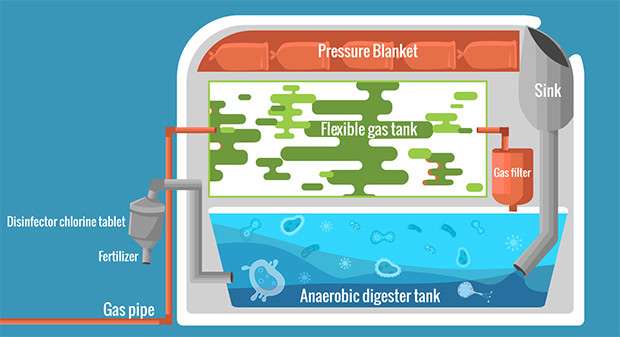December 1, 2015 weblog
Installing a cycle of energy at home: HomeBiogas offers bio-digester

Declining energy resources, environmental hazards, rural and urban pollution...going green appears to be a daunting task but a single family's effort to "go green" with a small product could make a big impact.
That is the reasoning that may motivate people to take up the Indiegogo campaign offer of HomeBiogas to use their system. They ask people to consider, what if they could turn their home waste into gas and fertilizer, thereby creating an in-house cycle of energy?
Going green could start in-house, unleashing a natural process where organic waste is converted into cooking gas.
Basically, you would be cooking your dinner with the gas produced from lunch's leftovers. The team said about 1 Kg / 2.2 pounds of food waste produces about 200 liters or 7 Cubic feet of gas, which generates around one hour of cooking over a high flame. The HomeBiogas bio-digester can serve "off the grid" urban and rural families.
The unit comes as a kit which one can assemble and then put in the back yard. TreeHugger offered more about the setup process: "The HomeBiogas units are also said to be simple to operate, and to require minimal annual maintenance, and although the biogas can be burned on a regular stove, at least one burner does need to be converted to use the fuel."
NoCamels.com: "For those who don't know what a bio-digester is, it takes organic material (like left-over food) and converts it into a fuel, known as biogas, through an anaerobic process carried out in a warm atmosphere. This fuel can then be used by a household for other purposes, like heating."
This is an outdoors system. It works optimally in places with average day/night temperatures above 17 °C. "Our system is not suited for cold or freezing temperatures," they said.
How it works: You throw in your organic waste. Any kitchen leftovers will do, including meat or dairy. Even pet litter is OK. Material is decomposed in the machine and biogas is released.
(Biogas is made up of several gases, primarily methane and carbon dioxide, which can be stored and directed for cooking. HomeBiogas' Ami Amir in NoCamels.com said it was as easy to use as a dish-washer and the system does not generate any foul odors." He added, "There are bacteria or microbes that thrive in conditions where there is no air (anaerobic) that are able to break down organic matter into their components. One of the results of this process is known as biogas, a combination of methane gas and carbon dioxide.")
As a byproduct of the digestion process, the system also creates fertilizer for plants.
TreeHugger said the unit measures 48"x65"x39.4" and weighs less than 88 pounds.
Five years ago, the team behind HomeBiogas went on a mission to bring BioGas into homes. The Israel-based team have passed the prototype phase.
They have installed over 150 units, running for over a year. They said they have worked with international organizations.
In the Indiegogo campaign page, reward offers with their prices vary but at the time of this writing there was an earlybird offer at $945 with estimated delivery in May.
More information: www.homebiogas.com/
© 2015 Tech Xplore


















